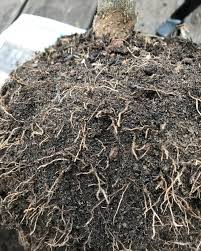Olive roots typically refer to the underground parts of an olive tree (Olea europaea), a species of small tree native to the Mediterranean region, western Asia, and northern Africa. The roots of an olive tree play a crucial role in the tree’s overall health, growth, and ability to extract water and nutrients from the soil.
Root System Structure: Olive trees have a complex root system consisting of a taproot and lateral roots. The taproot is the main central root that grows vertically downward, while lateral roots spread out horizontally from the taproot. Olive tree roots have adapted to survive in arid and semi-arid environments by developing a deep-rooted system, allowing them to access water stored deep in the soil.
Nutrient Absorption: The roots of olive trees absorb essential nutrients from the soil, including nitrogen, phosphorus, potassium, calcium, and various micronutrients required for the tree’s growth and development.
Interaction with Soil Microorganisms: The roots of olive trees establish symbiotic relationships with beneficial soil microorganisms, such as mycorrhizal fungi, which enhance nutrient uptake and overall tree health.
The Economic Importance and Uses of Olive Roots

Olive roots, like other parts of the olive tree, have several economic and practical uses.
Here are the economic importance and uses of
1. Olive Wood and Timber: Olive wood is highly valued for its hardness, density, and unique grain patterns. It is used to create various wood products, including furniture, flooring, decorative items, cutting boards, and utensils. The demand for olive wood products contributes to the economic value of olive trees, including their roots.
2. Soil Erosion Prevention: Olive roots play a crucial role in preventing soil erosion. Their extensive root systems help bind the soil, stabilize slopes, and reduce the risk of landslides. This is especially important in regions prone to erosion and soil degradation.
3. Soil Health and Fertility: Olive roots contribute to soil health by improving its structure and fertility. The roots interact with soil organisms, facilitate nutrient cycling, and enhance soil aeration. Healthy soils support better olive tree growth and productivity.
4. Olive Oil Production: While the main focus is typically on the olive fruit for oil production, healthy and well-established roots are essential for supporting robust olive tree growth. Healthy roots ensure efficient nutrient uptake, water absorption, and overall tree health, indirectly influencing olive oil production.
5. Olive Cultivation: Olive roots are fundamental for the establishment and growth of new olive trees. Rooted cuttings or saplings are used to start new olive groves. The health and vigor of the roots are crucial for the successful establishment and growth of these trees, directly impacting the olive cultivation industry.
6. Medicinal Uses: Although not a primary economic use, olive roots have been used in traditional medicine for various ailments. Infusions or extracts made from olive roots have been historically used to treat digestive issues, reduce fever, and aid in wound healing. However, modern medicine has not extensively validated these traditional uses.
7. Landscaping and Ornamental Purposes: Olive trees, including their roots, are often used for landscaping and ornamental purposes in parks, gardens, and public spaces. The aesthetic appeal of olive trees, including their characteristic root structures, adds value to landscaping projects.
8. Carbon Sequestration: Olive trees, through their roots and overall biomass, play a role in carbon sequestration. This contributes to efforts to mitigate climate change by removing carbon dioxide from the atmosphere and storing it in the soil and tree biomass.
Read Also: Olive Pulp: Economic Importance, Uses, and By-Products
The Products and By-products That Can Be Derived From Olive Roots
Olive roots, like other parts of the olive tree, can be utilized to produce various products and by-products.
Here’s a list of potential products and by-products that can be derived from olive roots:
1. Firewood and Charcoal: Olive roots can be harvested and dried to produce firewood, which is commonly used for heating or cooking. They can also be converted into charcoal through a controlled burning process.
2. Woodworking and Crafts: Olive root wood can be used in woodworking to create decorative items, furniture, or crafts due to its unique grain patterns and durability.
3. Biofuel: Olive roots can be used to produce biofuels through processes such as pyrolysis or gasification. This includes biochar, which can be used as a soil amendment.
4. Herbal and Medicinal Extracts: Olive roots may contain compounds that have potential medicinal properties. Extracts can be obtained and used in traditional or alternative medicine.
5. Natural Dyes: Olive root bark can be used to extract natural dyes for textiles and various arts and crafts.
6. Mushroom Cultivation: Olive roots can serve as a substrate for cultivating certain types of mushrooms, such as the Lion’s Mane mushroom.
7. Compost and Soil Amendments: Olive roots, when composted or used as mulch, can contribute to enriching soil structure and enhancing soil fertility.
8. Animal Bedding: Chopped or processed olive root material can be used as bedding for animals in agricultural settings.
9. Landscaping and Erosion Control: Olive roots can be utilized for erosion control and landscaping, particularly in areas where their extensive root systems can help stabilize soil.
10. Tannin Extraction: Olive roots may contain tannins that can be extracted for use in tanning hides or other industrial applications.
11. Pulp and Paper Products: Olive roots can be used in the production of paper and pulp products, contributing to the paper industry.
12. Insect Repellent: Extracts from olive roots may possess insect-repellent properties and could be used in natural insect repellent formulations.
In conclusion, olive roots contribute to various economic activities, including the production of wood products, olive oil, and olive cultivation. They also play a critical role in preventing soil erosion, enhancing soil health, supporting the growth of olive trees, and contributing to environmental sustainability.
Read Also: The Role of Agri Banks in Sustainable Food Systems
